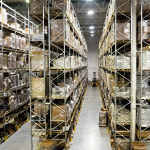Automation & Digital Transformation
Automatic equipment in a manufacturing, warehousing and distribution, Industrial and Autonomous research robots, Robotic process automation (RPA) and other processes or facilities.Improving the remote work experience: How can process automation aid remote working?

Whilst many companies have been gradually embracing and moving to remote working, today’s uncertain climate has resulted in mass numbers of employees working from home under government guidance. This is forcing organisations to rapidly change their processes and introduce new technologies to ensure business as usual.
According to research from the Office of National Statistics (ONS) the number of UK workers who have moved into remote working has increased by nearly a quarter of a million over the last decade. Remote working is undoubtedly on the rise and over the last few months, turmoil has hit businesses leading to this being the norm for many companies. Employees by the thousands have set up desks and moved business processes to the comfort of their homes. As a result, the implementation of remote working aid and technology by necessity has quickly followed suit in order to support employees during this difficult time and consequently lessening the impact of change.
But just how much can process automation aid businesses with remote working and how will this change help to benefit and promote growth in the future? This immediate rewiring of business processes is changing organisational capabilities, skill sets, processes, structure, and managerial mindsets. Existing technology, workplace culture, and data are all required to align to optimise this technology deployment.
Justin Borradaile, Senior Vice President of Global Shared Business Services at RS Components and the Electrocomponents Group below discusses the advantages of advanced digital implementation and how process automation can drive more connection and collaboration to businesses than ever before.
Drive efficiencies
As new technologies, such as robotic management and IoT, are embraced at a rapid rate, businesses are seeing the benefits of this investment – an investment that is likely to continue in the future. We’re seeing that digital transformation is painting a clear picture of what the future could hold and how automation has a definite home. In a recent report from Willis Towers Watson, they revealed that 57% of employers say that the main outcome of automation is the augmentation of worker performance and productivity.
Automation is helping businesses now more than ever before. So what impact is automation having during the pandemic? Within the logistics industry, automation is being used to protect workers from unnecessary exposure to pathogens, and within the health industry, an increased number of robots are being used to clean hospital beds. The retail sector is also making use of automation, through digital payments to remove the need for exchanging cash money.
The pandemic has also caused corporations to also readjust their paid leave, alter their sick day policies, and use automated messages to communicate HR and Finance changes across businesses.
Justin adds:
“We are going through a dramatic shift in how we work and, what we can take positively from this, is the flourishing platform of a digital ecosystem. Businesses are implementing the technology in a multitude of ways to aid business processes such as remotely onboarding employees, acknowledging customer messages, and managing employee status reports.”
Deepening monitoring abilities
Digital processes can keep a record of interactions between employees, keep track of progress towards goals, and ensure that team members are notified of any company changes. In addition, monitoring methods can provide organisations with in-depth insight into remote workforce productivity and means that management teams can further identify any automation opportunities to continue to ease any burden on employees.
Speaking on the subject, Justin adds:
“Data such as this is critical for managers at this time of increased levels of remote working, particularly where we have many of our team for whom this is a new experience and way of working. The insights we are gaining support us in making correct, relevant, beneficial changes and decisions with regards to resourcing levels, training requirements and can identify where there are issues, for example connectivity problems, and where any additional support may be needed to manage workloads. The insights we now have are actually driving us to be even more productive than prior to the lockdown.”
Providing additional support
The climate is changing daily, and one thing that is for certain is the increased amount of support we’re seeing throughout businesses. From a technology standpoint, managerial teams should be doing all they can to support their employees, customers, and clients. Automation is an aid that can reduce personnel time spent on processes, such as data transcription and maintenance reporting, and it ultimately frees time for employees to focus on what matters in the here and now for both their team and business.
Improving reporting
Automation can be implemented to take away elements of the reporting process, especially those elements that do not require human input. In addition to this, automating reporting can also increase the data you extract from your business systems providing stakeholders with wider access to data than ever before and unlocking new opportunities to drive change within your business. For example, this data insight can highlight what is working well for your remote workers and what areas could be improved to drive efficiency.
Justin comments:
“Businesses continue to seek methods that will improve processes for the best financial outcomes, reporting automation provides you with vital insight into your business that can bring about change which drives further growth. It can provide stakeholders with data insights they previously did not have access to, whilst eradicating the risk of human error.”
Automation is helping businesses to do more with fewer resources. It is proving to be one of the most valuable technologies to keep teams working effectively and for businesses to continue moving forward in this current climate. Whilst many businesses may be feeling the pressure to implement automation, the investment will have substantial benefits to businesses in the future. Automation is a key component to bolster connectivity and to augment workforces everywhere.










